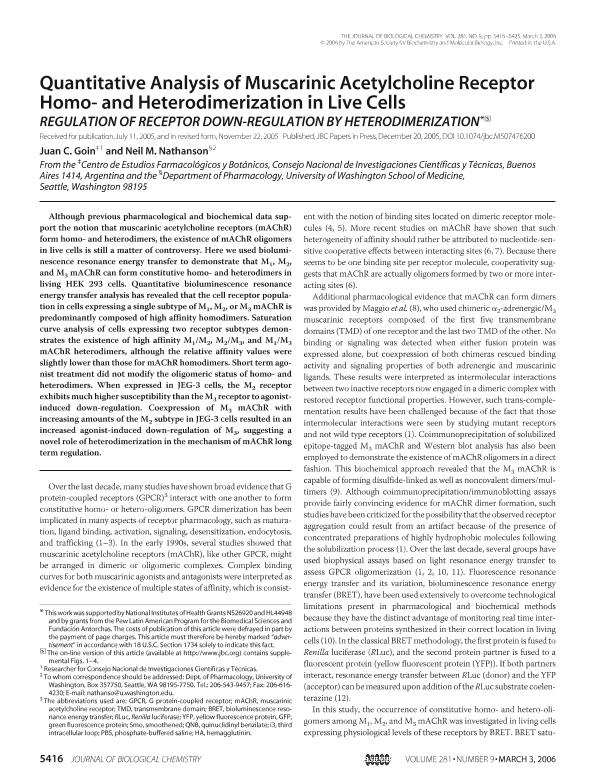Artículo
Quantitative analysis of homo- and heterodimerization of muscarinic acetylcholine receptors in live cells
Fecha de publicación:
03/2006
Editorial:
American Society for Biochemistry and Molecular Biology
Revista:
Journal of Biological Chemistry
ISSN:
0021-9258
Idioma:
Inglés
Tipo de recurso:
Artículo publicado
Clasificación temática:
Resumen
Although previous pharmacological and biochemical data support the notion that muscarinic acetylcholine receptors (mAChR) form homo- and heterodimers, the existence of mAChR oligomers in live cells is still a matter of controversy. Here we used bioluminescence resonance energy transfer to demonstrate that M1, M2, and M3 mAChR can form constitutive homo- and heterodimers in living HEK 293 cells. Quantitative bioluminescence resonance energy transfer analysis has revealed that the cell receptor population in cells expressing a single subtype of M1, M2, or M3 mAChR is predominantly composed of high affinity homodimers. Saturation curve analysis of cells expressing two receptor subtypes demonstrates the existence of high affinity M1/M2, M2/M3, and M1/M3 mAChR heterodimers, although the relative affinity values were slightly lower than those for mAChR homodimers. Short term agonist treatment did not modify the oligomeric status of homo- and heterodimers. When expressed in JEG-3 cells, the M2 receptor exhibits much higher susceptibility than the M3 receptor to agonist-induced down-regulation. Coexpression of M3 mAChR with increasing amounts of the M2 subtype in JEG-3 cells resulted in an increased agonist-induced down-regulation of M3, suggesting a novel role of heterodimerization in the mechanism of mAChR long term regulation.
Palabras clave:
Machr
,
Dimerization
,
Down-Regulation
,
Bret
Archivos asociados
Licencia
Identificadores
Colecciones
Articulos(CEFYBO)
Articulos de CENTRO DE ESTUDIOS FARMACOLOGICOS Y BOTANICOS
Articulos de CENTRO DE ESTUDIOS FARMACOLOGICOS Y BOTANICOS
Citación
Goin, Juan Carlos; Nathanson, Neil M.; Quantitative analysis of homo- and heterodimerization of muscarinic acetylcholine receptors in live cells; American Society for Biochemistry and Molecular Biology; Journal of Biological Chemistry; 281; 9; 3-2006; 5416-5425
Compartir
Altmétricas




